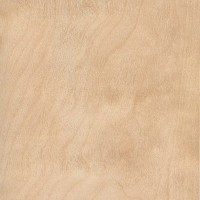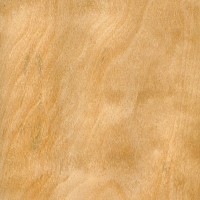 |
Common Name(s): Silver Birch Scientific Name: Betula pendula Distribution: Europe and southwest Asia Tree Size: 65-100 ft (20-30 m) tall, 1-2 ft (.3-.6 m) trunk diameter Average Dried Weight: 40 lbs/ft3 (640 kg/m3) Specific Gravity (Basic, 12% MC): .50, .64 Janka Hardness: 1,210 lbf (5,360 N) Modulus of Rupture: 16,570 lbf/in2 (114.3 MPa) Elastic Modulus: 2,024,000 lbf/in2 (13.96 GPa) Crushing Strength: No data available Shrinkage: No data available |
Color/Appearance: Heartwood tends to be a light reddish brown, with nearly white sapwood. Occasionally figured pieces are available with a wide, shallow curl similar to the curl found in Cherry. There is virtually no color distinction between annual growth rings, giving Birch a somewhat dull, uniform appearance.
Grain/Texture: Grain is generally straight or slightly wavy, with a fine, even texture. Low natural luster.
Endgrain: Diffuse-porous; primarily radial multiples; medium pores in no specific arrangement, moderately numerous to numerous; parenchyma marginal, and sometimes diffuse-in-aggregates (faintly visible with lens); narrow rays, spacing fairly close to close.
Rot Resistance: Birch is perishable, and will readily rot and decay if exposed to the elements. The wood is also susceptible to insect attack.
Workability: Generally easy to work with hand and machine tools, though boards with wild grain can cause grain tearout during machining operations. Turns, glues, and finishes well.
Odor: No characteristic odor.
Allergies/Toxicity: Birch in the Betula genus has been reported as a sensitizer. Usually most common reactions simply include skin and respiratory irritation. See the articles Wood Allergies and Toxicity and Wood Dust Safety for more information.
Pricing/Availability: Likely to be rather economical in most instances. Figured boards can be more expensive, but normally plain birch lumber is in the same price range as maple or oak.
Sustainability: This wood species is not listed in the CITES Appendices or on the IUCN Red List of Threatened Species.
Common Uses: Plywood, boxes, crates, turned objects, interior trim, and other small specialty wood items.
Comments: Birch is one of the most widely used woods for veneer and plywood worldwide. Besides regular sheets of plywood, Birch veneer is also used for doors, furniture, and paneling.
Scans/Pictures: A special thanks to Steve Earis for providing the wood sample of this wood species.



Turned bowl, from silver birch
I would like to add that massive birch is the most popular hardwood in Finland and the northern parts of scandinavia. It makes for excellent furniture material on its own as long as it’s indoors. It is the main hardwood in use up here. It is our version of oak or maple.
High quality firewood is also from birch.
Indeed, I find it also has a very nice tone to it when used in instruments. A little warmer than hard maple for example, very pleasing to my ears.